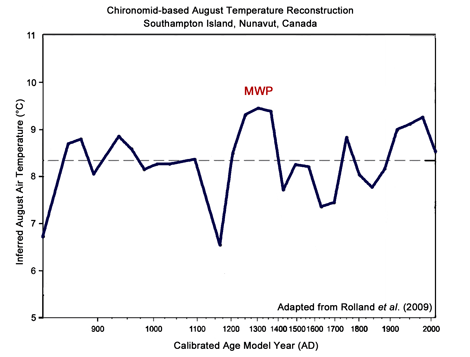Reference
Rolland, N., Larocque, I., Francus, P., Pienitz, R. and Laperriere, L. 2009. Evidence for a warmer period during the 12th and 13th centuries AD from chironomid assemblages in Southampton Island, Nunavut, Canada. Quaternary Research 72: 27-37.
Description
Working in Nunavut, Canada, Rolland et al. developed a 1200-year history of August air temperature above a lake on Southampton Island located at 65°05'N, 83°47'W by analyzing fossil chironomid distributions and X-ray fluorescence, grain size and C/N ratios of sediments obtained from a gravity core retrieved from the lake's deepest point. This work revealed that (1) "higher temperatures were recorded from cal yr AD 1160 to AD 1360, which may correspond to the Medieval Warm Period," and that (2) "between cal yr AD 1360 and AD 1700, lower temperatures were probably related to a Little Ice Age event," the latter of which periods exhibited a minimum August temperature that was "ca. 2°C colder than the maximum observed during the Medieval Warm Period." Also of note, as can be seen from the figure below, the most recent August temperature (which occurs at the end of the record at about AD 2008) is approximately 0.9°C less than the maximum August temperature of the Medieval Warm Period.

Inferred August air temperature over Lake 4 of Nunavut, Canada's Southampton Island vs. time. Adapted from Rolland et al. (2009).




